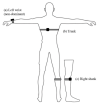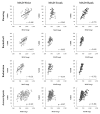Ideal Combinations of Acceleration-Based Intensity Metrics and Sensor Positions to Monitor Exercise Intensity under Different Types of Sports
- PMID: 35408199
- PMCID: PMC9003469
- DOI: 10.3390/s22072583
Ideal Combinations of Acceleration-Based Intensity Metrics and Sensor Positions to Monitor Exercise Intensity under Different Types of Sports
Abstract
This study quantified the strength of the relationship between the percentage of heart rate reserve (%HRR) and two acceleration-based intensity metrics (AIMs) at three sensor-positions during three sport types (running, basketball, and badminton) under three intensity conditions (locomotion speeds). Fourteen participants (age: 24.9 ± 2.4 years) wore a chest strap HR monitor and placed three accelerometers at the left wrist (non-dominant), trunk, and right shank, respectively. The %HRR and two different AIMs (Player Load per minute [PL/min] and mean amplitude deviation [MAD]) during exercise were calculated. During running, both AIMs at the shank and PL at the wrist had strong correlations (r = 0.777-0.778) with %HRR; while other combinations were negligible to moderate (r = 0.065-0.451). For basketball, both AIMs at the shank had stronger correlations (r = 0.604-0.628) with %HRR than at wrist (r = 0.536-0.603) and trunk (r = 0.403-0.463) with %HRR. During badminton exercise, both AIMs at shank had stronger correlations (r = 0.782-0.793) with %HRR than those at wrist (r = 0.587-0.621) and MAD at trunk (r = 0.608) and trunk (r = 0.314). Wearing the sensor on the shank is an ideal position for both AIMs to monitor external intensity in running, basketball, and badminton, while the wrist and using PL-derived AIM seems to be the second ideal combination.
Keywords: acceleration; racquet sports; running; team sports; wearable electronic devices.
Conflict of interest statement
The authors declare no conflict of interest.
Figures







Similar articles
-
Better position for the wearable sensor to monitor badminton sport training loads.Sports Biomech. 2024 Apr;23(4):503-515. doi: 10.1080/14763141.2021.1875033. Epub 2021 Mar 4. Sports Biomech. 2024. PMID: 33663329
-
Intensity Thresholds on Raw Acceleration Data: Euclidean Norm Minus One (ENMO) and Mean Amplitude Deviation (MAD) Approaches.PLoS One. 2016 Oct 5;11(10):e0164045. doi: 10.1371/journal.pone.0164045. eCollection 2016. PLoS One. 2016. PMID: 27706241 Free PMC article.
-
Movements with greater trunk accelerations and their properties during badminton games.Sports Biomech. 2020 Jun;19(3):342-352. doi: 10.1080/14763141.2018.1478989. Epub 2018 Jun 18. Sports Biomech. 2020. PMID: 29912632
-
The Relationships Between Internal and External Measures of Training Load and Intensity in Team Sports: A Meta-Analysis.Sports Med. 2018 Mar;48(3):641-658. doi: 10.1007/s40279-017-0830-z. Sports Med. 2018. PMID: 29288436 Review.
-
Interactive processes link the multiple symptoms of fatigue in sport competition.Sports Med. 2011 Apr 1;41(4):307-28. doi: 10.2165/11586070-000000000-00000. Sports Med. 2011. PMID: 21425889 Review.
Cited by
-
Bipedal Static Supination and Dynamic Forefoot Loading Characteristics in Taiwanese College Badminton Players: A Cross-Sectional Study.Bioengineering (Basel). 2023 Apr 21;10(4):498. doi: 10.3390/bioengineering10040498. Bioengineering (Basel). 2023. PMID: 37106685 Free PMC article.
-
Performance of Different Accelerometry-Based Metrics to Estimate Oxygen Consumption during Track and Treadmill Locomotion over a Wide Intensity Range.Sensors (Basel). 2023 May 25;23(11):5073. doi: 10.3390/s23115073. Sensors (Basel). 2023. PMID: 37299803 Free PMC article.
-
Wearable and Portable Devices for Acquisition of Cardiac Signals while Practicing Sport: A Scoping Review.Sensors (Basel). 2023 Mar 22;23(6):3350. doi: 10.3390/s23063350. Sensors (Basel). 2023. PMID: 36992060 Free PMC article.
References
-
- Thompson W.R. Worldwide survey of fitness trends for 2019. ACSMs Health Fit. J. 2018;22:10–17. doi: 10.1249/FIT.0000000000000438. - DOI
-
- Thompson W.R. Worldwide survey of fitness trends for 2020. ACSMs Health Fit. J. 2019;23:10–18. doi: 10.1249/FIT.0000000000000526. - DOI
-
- Thompson W.R. Worldwide survey of fitness trends for 2021. ACSM Health Fit. J. 2021;25:10–19. doi: 10.1249/FIT.0000000000000631. - DOI
MeSH terms
Grants and funding
LinkOut - more resources
Full Text Sources

